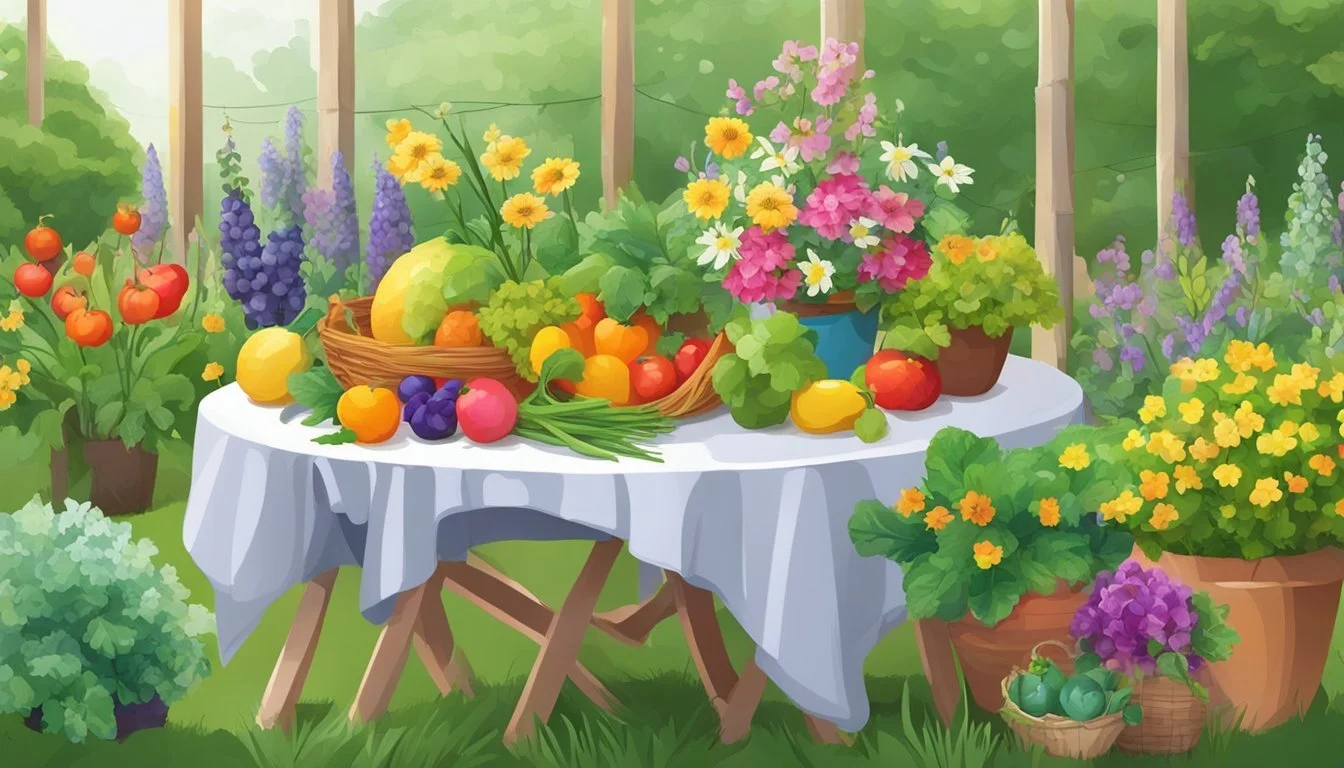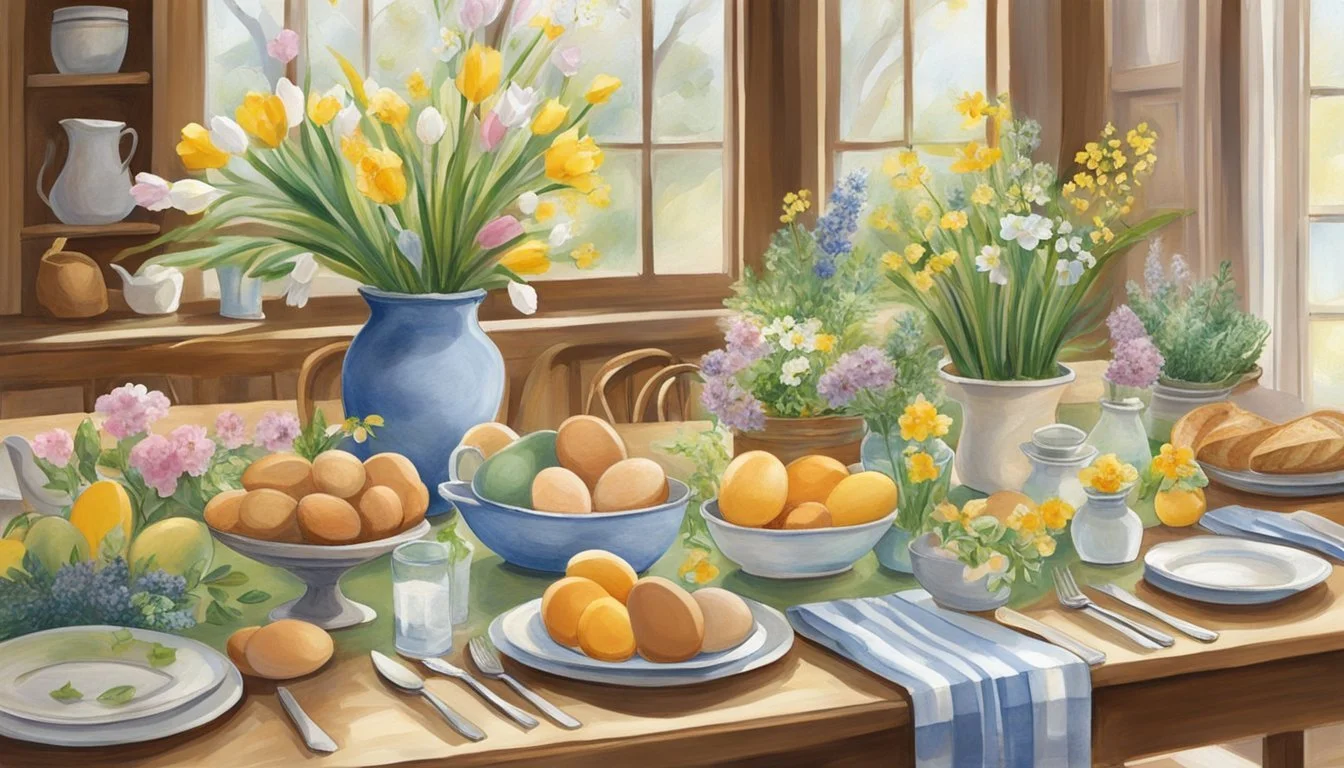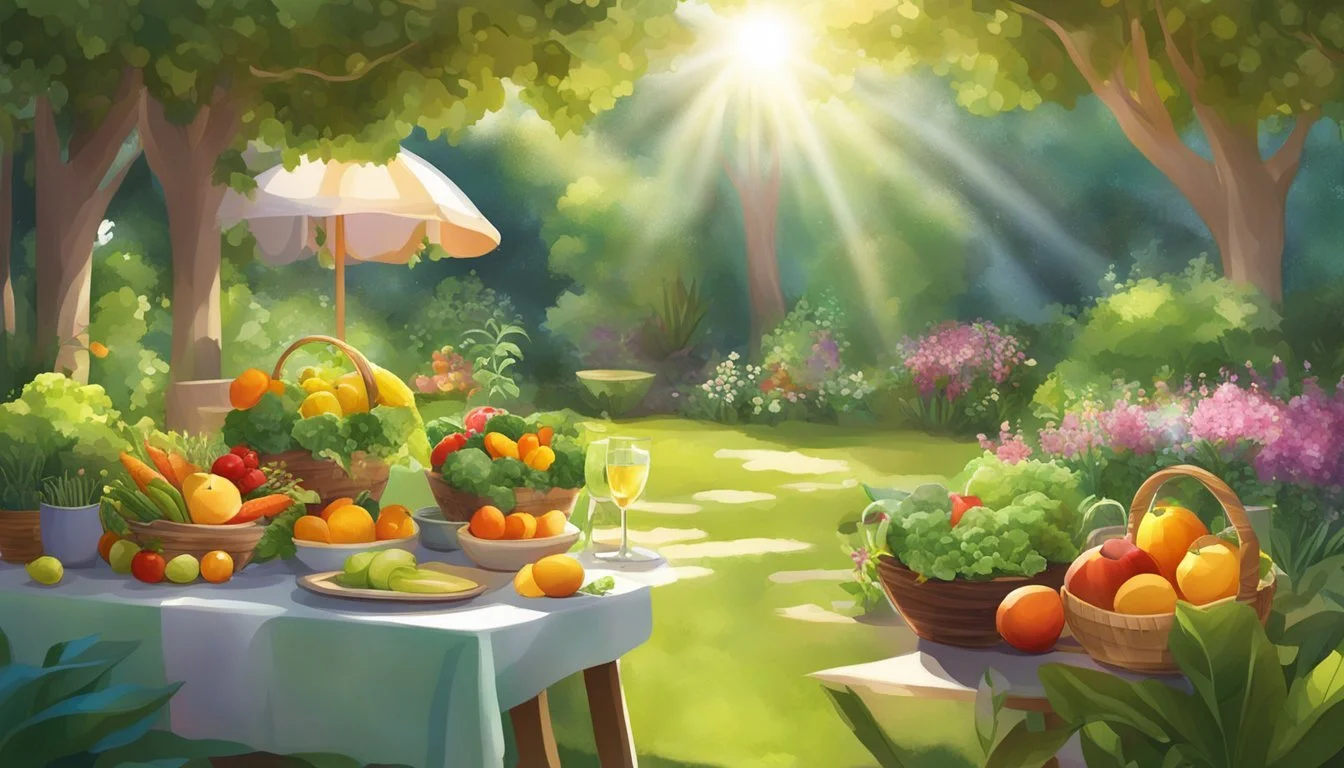Garden to Table
Growing Your Own Easter Feast Essentials
Easter is a time of renewal and hope, deeply rooted in Christian faith, heralding the return of spring and symbolizing the resurrection. As families gather to celebrate, incorporating garden-fresh ingredients into the Easter feast ties the spiritual meaning of the holiday to the earth's natural renewal. Growing your own vegetables and herbs enhances the festive meal with flavors that embody the season's freshness and the spirit of rebirth.
The concept of 'garden to table' is gaining momentum as more individuals seek to connect with their food sources and enjoy the benefits of home-grown produce. It promotes sustainability, wellness, and a deeper appreciation for the bounty that gardens provide. By cultivating a garden with the intent of preparing an Easter feast, one not only honors the essence of the holiday but also engages in a fulfilling endeavor that yields both physical and spiritual nourishment.
In preparing for an Easter feast sourced from one's own garden, the selection of crops reflects the themes of hope and renewal. Leafy greens, tender asparagus, and bright spring onions, planted and nurtured with care, become more than just ingredients; they are a testament to the care and attention invested in the land. The harvest, transformed into dishes shared amongst loved ones, becomes a celebration of life's perpetual cycle and the joy found in simple, earthly pleasures.
Understanding Easter Traditions
Easter traditions reflect a rich tapestry of cultural and religious practices that commemorate the resurrection of Jesus. The holiday is infused with symbols of new life and rebirth, represented through various customs, foods, and decorations.
The Significance of Easter Sunday
Easter Sunday marks the climax of Lent, a 40-day period of fasting and repentance. On this day, Christians around the world celebrate the resurrection of Jesus Christ from the tomb, which is considered the cornerstone of their faith. The event signifies victory over death and the promise of eternal life.
Symbols of Resurrection and Renewal
Symbols are integral to Easter's narrative, with the cross epitomizing Jesus' sacrifice and the empty tomb his resurrection. These symbols underscore themes of redemption and renewal. Oftentimes, eggs are used to represent new life, and the practice of painting eggs can be seen as a nod to the vibrancy of spring and the renewal of the earth.
The Role of Plants and Flowers
Flowers often play a symbolic role in Easter celebrations. White lilies, associated with purity and resurrection, are commonly used to decorate churches and homes. Additionally, flowers like daffodils and tulips, which bloom in spring, reinforce themes of new beginnings and renewal.
Connecting Easter to the Garden
Gardens have a special connection with Easter, with many traditions incorporating elements from the garden to symbolize life and growth. This time of year provides an opportunity to cultivate a garden that not only beautifies but also brings the essence of Easter to the table with home-grown fruits, vegetables, and herbs.
Planning Your Easter Garden Project
When embarking on an Easter garden project, one should consider the location, the types of plants that embody the season, and the necessary materials and tools to bring the garden to life.
Choosing the Right Location
The right location is pivotal for the success of any garden. A sunny location is essential as most Easter plants require adequate sunlight to thrive. One should ensure that the chosen spot receives at least 6-8 hours of direct sunlight daily. If space is limited or soil conditions are poor, a container garden could be a viable alternative, using high-quality potting soil to promote plant health.
Selecting Appropriate Easter Plants
Plant selection should align with the Easter theme, incorporating plants such as lilies, tulips, daffodils, and hyacinths which are emblematic of the season. These plants typically require well-draining soil and should be planted at a depth and spacing that allows room for growth. Here is a simple guide for planting Easter seeds:
Plant Depth Spacing Sunlight Requirement Lilies 4-6 inches 12-18 inches Full sun to part shade Tulips 4-6 inches 4-6 inches Full sun to part shade Daffodils 6-8 inches 4-6 inches Full sun to part shade Hyacinths 4 inches 3 inches Full sun to part shade
Materials and Tools Necessary for Your Garden
To commence the project, gardeners need a range of materials and tools. The essentials include seeds or plant bulbs specific to the chosen Easter plants, potting soil, and suitable containers if not planting directly in the ground. Basic tools required are a trowel, gardening gloves, watering can or hose, and scissors or twine for staking or trellising plants as they grow. Here is a list of the basic tools and materials one might need:
Trowel
Gardening gloves
Watering can/hose
Scissors/Twine
Plant seeds/bulbs
Potting soil/Soil amendments
Containers (if applicable)
Labels/markers
One should also consider accessibility for watering and maintenance, as well as protection from potential pests or inclement weather. With the right planning and execution, the Easter garden will be a bountiful and symbolic centerpiece for the holiday feast.
Creating a Resurrection Garden
A Resurrection Garden serves as a horticultural representation of the Easter story, combining elements of gardening with symbolic cues that reference the resurrection of Christ. This tangible display fosters reflection and educational opportunities, especially when engaging children in the process.
Steps for Assembling Your Garden
To assemble a Resurrection Garden, one will need:
A container or pot
Potting soil or garden dirt
A small clay pot or cup for the tomb
A large stone to represent the tomb’s sealing rock
Grass seed or moss for greenery
Twigs and string to create crosses
The assembly is straightforward:
Fill the container with soil, leaving enough depth for planting.
Place the small pot on its side to act as the tomb and position it within the container.
Set the large stone partially in front of the opening to symbolize the tomb's covering.
Plant grass seeds or place moss around the soil to resemble ground cover.
Construct three crosses from twigs and place them on a hill above the tomb.
Water the seeds and position the garden in a location with appropriate sunlight.
Symbolism Behind the Elements
Each element in the Resurrection Garden carries symbolic significance:
The soil represents the earth wherein the story unfolds.
Moss or grass growing symbolizes hope and new life.
The tomb, made from the clay pot or cup, stands as the burial place.
The large stone reflects the sealed entrance to the tomb.
Twigs fashioned into crosses are reminders of the crucifixion.
Finally, rolling the stone away reminds onlookers of the empty tomb and resurrection.
Involving Children in the Project
Creating a Resurrection Garden is an excellent DIY activity for children. They can:
Assist in filling the container with soil and setting the tomb in place.
Learn about plant growth by sowing the grass seeds.
Express creativity by arranging the moss and constructing crosses.
Understand the Easter story through the tangible elements of the garden.
Allowing children to partake in the creation and care of the garden instills a sense of responsibility and helps them connect with the story of Easter on a personal level.
Garden to Table: Preparing for the Feast
In anticipation of a memorable Easter feast, one can embrace the journey from tending the garden to the artful presentation on the dining table. This section covers cultivating your own ingredients, setting an inspiring table for Easter, and creating your own table decor.
From Soil to Plate: Growing Your Ingredients
Gardeners understand that fresh, home-grown ingredients are the cornerstone of any garden-to-table meal. For an Easter dinner, one might plant a variety of lettuces, radishes, and herbs, which flourish in the cool spring climate. Be sure to sow seeds like carrots and potatoes much earlier, as those root vegetables take longer to mature. It's also a perfect time to employ companion planting strategies; for example, planting onions near carrots may help deter carrot flies.
Vegetable Garden Plan:
Vegetable Planting Time Harvest Time Lettuce Early Spring 45-55 days Radishes 4-6 weeks before the last frost 30 days Carrots 3-5 weeks before the last frost 70-80 days Potatoes 2-4 weeks before the last frost 90-120 days
Setting an Inspirational Easter Table
The Easter table setting is integral to the festive atmosphere. They should select a color scheme that complements the freshness of the garden, such as soft greens, pastel yellows, and bright whites. Use natural materials like linen for tablecloths and napkins for an earthy texture. For a cohesive look, they might choose dinnerware that echoes the hues of the freshly harvested vegetables.
Table Setting Tips:
Color Palette: Soft green, pastel yellow, white
Materials: Linen, ceramic, glass
Arrangement: Plate in the center, fork on the left, knife and spoon on the right
DIY Table Decor and Centerpieces
Creating table decor and centerpieces draws inspiration from the garden, reinforcing the theme of the feast. They might construct a centerpiece featuring a mix of flowering spring plants and greenery. Edible herbs arranged in small pots not only add to the aesthetic but can also be part of the meal. For a personal touch, guests can be welcomed with handwritten place cards nestled in sprigs of rosemary or thyme.
Centerpiece Ideas:
Potted spring flowers: daffodils, tulips, hyacinths
A basket filled with colored eggs amidst fresh greenery
Herb pots: rosemary, thyme, parsley
By involving one's cultivated ingredients, the spirit of Easter permeates through the entire dining experience, from the care taken in growing the food to the details in table setting and decor.
Decorating the Dining Room for Easter
Transforming your dining room for Easter involves creating a festive tablescape, crafting personalized baskets and place cards, and selecting harmonious colors for a cohesive look. Thoughtful touches like a well-chosen centerpiece can turn a regular dining room into a celebratory Easter haven.
Easter-Themed Tablescapes
In planning an Easter tablescape, one should always consider incorporating elements that reflect the season. A centerpiece with spring flowers such as tulips and daffodils adds a lively burst of color. For an interactive element, consider mini potted plants that guests can take home. Placemats in pastel shades serve as a foundation for table settings that can include thematic decorations like egg-shaped napkin rings or bunny-shaped menu holders.
Centerpiece Idea: Fresh tulips, daffodils, and hyacinths in a clear vase
Table Settings: Pastel placemats, gold cutlery, and napkins tied with twine and greenery
Crafting Easter Baskets and Place Cards
Personalized Easter baskets can double as place card holders and extra decoration on the table. They might be filled with a mix of decorative eggs, sweets, and a small gift. Place cards can be attached to the baskets or carefully positioned on the table, and they add a special touch, making guests feel welcomed and considered.
Easter Basket Content: Chocolate eggs, a small potted plant, and a personalized note
Place Card Design: Cardstock with calligraphy names and a ribbon that matches the table's color palette
Choosing a Color Palette for Your Table Display
The choice of a color palette sets the mood for any festivity. For Easter, soft pastels or bright floral hues typically create a cheerful atmosphere. The palette should extend cohesively from the centerpieces to the candles, tablecloth, and even the Easter baskets. Ensuring consistency in color helps to unify the table decor and create a visually pleasing dining experience.
Suggested Palette: Dusty rose, sage green, and creamy yellow
Tablecloth and Napkin Pairing: Ivory tablecloth with dusty rose napkins
By focusing on these details when decorating the dining room, one can craft a delightful setting fitting for an Easter celebration that brings family and friends together around the table.
Advanced Gardening Tips and Tricks
Incorporating live elements and sustainable practices, this section offers specific insights into elevating your Easter celebrations with homegrown elements.
Utilizing Wheatgrass for Live Table Settings
For a vibrant and eco-friendly table display, one can grow wheatgrass, a popular choice for Easter grass. To ensure a thick and even growth, evenly spread the grass seed over moist potting soil in a shallow tray. Covering the seeds with a thin soil layer and using a spray bottle for gentle watering can prevent dislodging the seeds. A bright location without direct sunlight is ideal for growth.
Creating Miniature Gardens in Containers
Miniature gardens bring a touch of whimsy to Easter decor. Choose containers with drainage holes and fill them with a mix of potting soil and compost for nutrient-rich environment. When designing a miniature garden, incorporate small plants with different textures and heights. Use decorative elements like twine to create tiny trellises or boundaries, enhancing the garden's visual appeal.
Container Selection:
Ensure proper drainage
Consider size and depth for plant roots
Plant Selection:
Opt for small, slow-growing varieties
Arrange plants for a layered look
Decoration:
Use natural materials like twine for authenticity
Add miniature furniture or figures for a storybook effect
Maintaining Your Easter Plants Beyond the Holiday
Easter plants such as lilies and tulips can be a lasting addition to one's garden. After the festivities, acclimatize the plants by gradually introducing them to outdoor conditions. Replant them in suitable outdoor containers or garden beds with well-draining soil. Regular watering and removal of spent blooms help promote future growth, ensuring lasting beauty well beyond the holiday season.
Promoting Your Garden to Table Project
When rolling out a Garden to Table project for Easter, savvy promotion is key to attracting an audience and showcasing the rewards of homegrown bounty. Social media offers vast platforms for gardeners to connect and share, while well-captured images become a testament to the project's success.
Social Media Strategies for Gardeners
Gardeners can utilize platforms like Instagram and Pinterest to share their journey, from seedling to Easter table centerpiece. On Instagram, they should focus on using relevant hashtags such as #GardenToTable, #EasterFeast, and #HomeGrown to reach like-minded communities. It's important to post consistently and engage with followers by sharing tips and seeking advice.
Pinterest provides a visual backdrop where gardeners can create inspirational boards. A board might feature garden planning, progress photos, Easter table decor, and flower arrangements. Pinners often look for DIY ideas, so including steps on creating a brunch (What wine goes well with brunch?) centerpiece or how to incorporate homegrown ingredients into Easter baskets can drive substantial traffic to their profiles.
Instagram Tips:
Use relevant hashtags: #GardenToTable, #EasterBrunch, #SustainableEating
Engage with the community: follow similar accounts, comment and share advice
Pinterest Strategies:
Create themed boards: 'Easter Garden Inspirations', 'From Garden to Brunch Table'
Include DIY tutorials: steps for table decor, building an Easter basket with garden elements
Capturing the Perfect Easter Photo
The power of a picture can’t be overstated, particularly when it comes to food and festivities. Gardeners should capture their table decor and dish presentations in natural light, which emphasizes the freshness and vibrancy of their homegrown produce. A high-quality photo acts as a visual invitation, enticing viewers to learn more about the project.
To make each photo stand out, gardeners can consider the following:
Composition: Place the Easter centerpiece in focus, with a background of garden greenery to reinforce the garden-to-table concept.
Authenticity: Capture candid moments of preparation or enjoyment around the brunch table, as they resonate well with viewers seeking a genuine experience.
By leveraging these techniques, gardeners can effectively promote their Garden to Table projects and inspire others to start their own sustainable Easter traditions.




